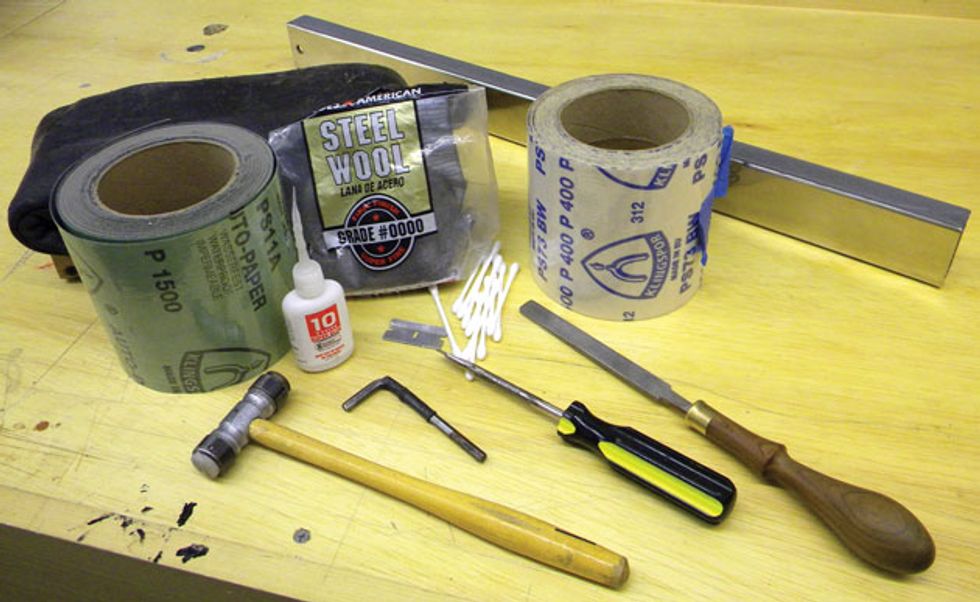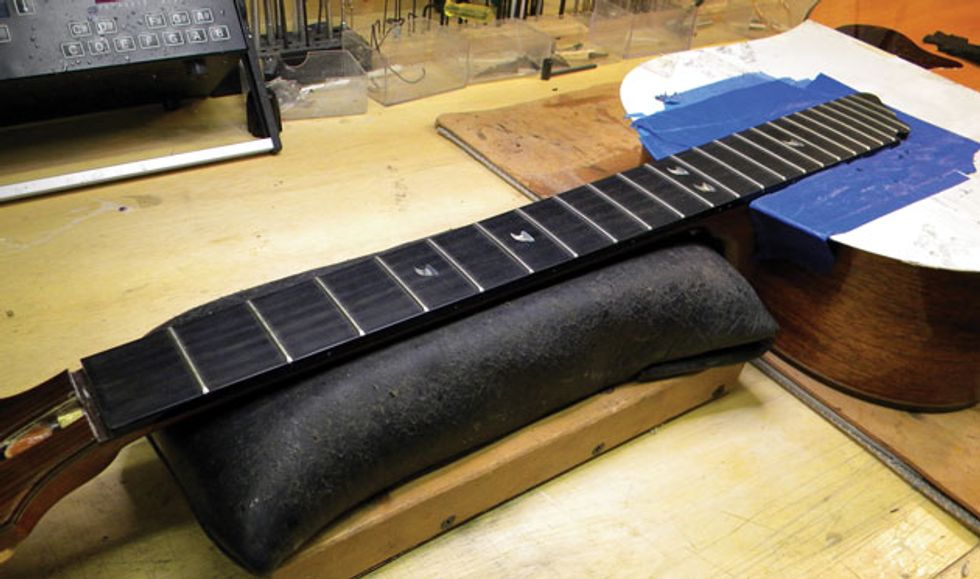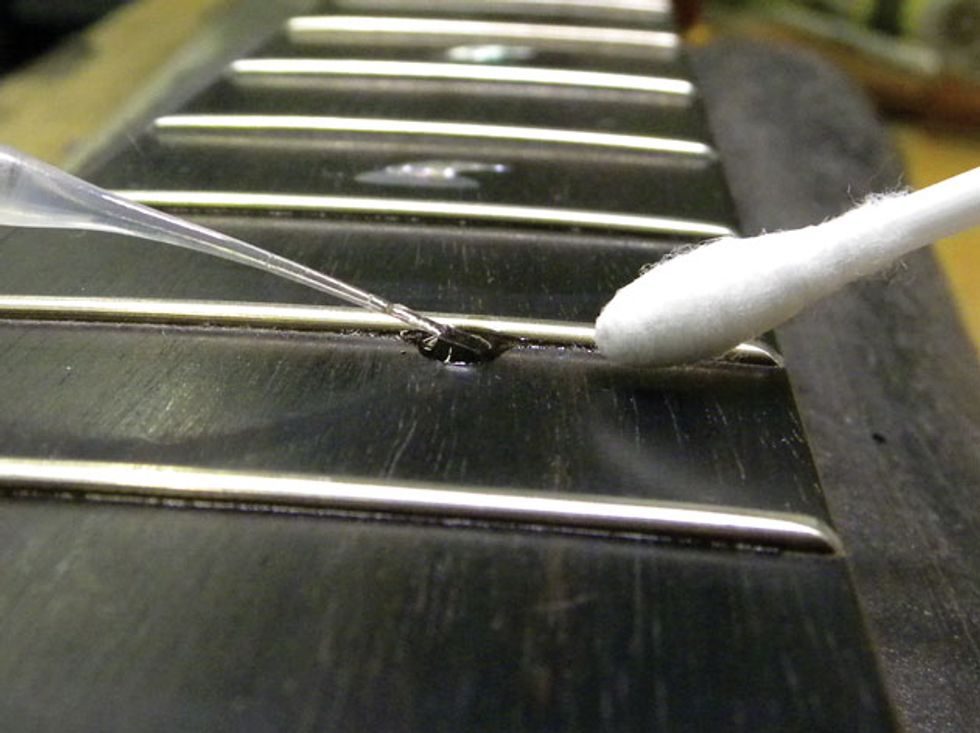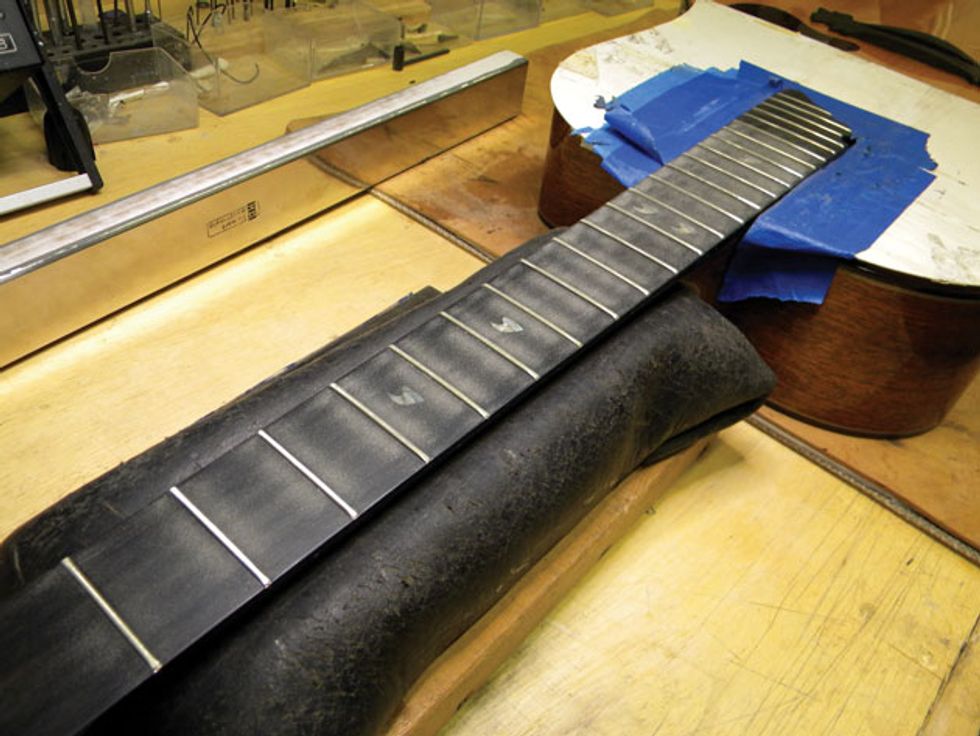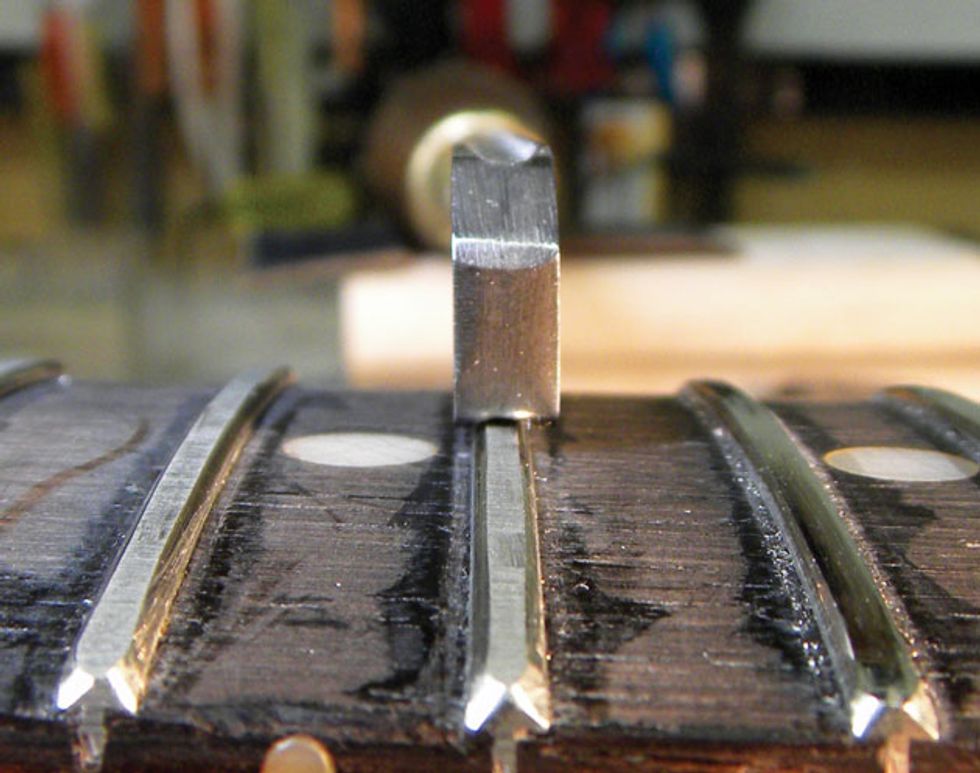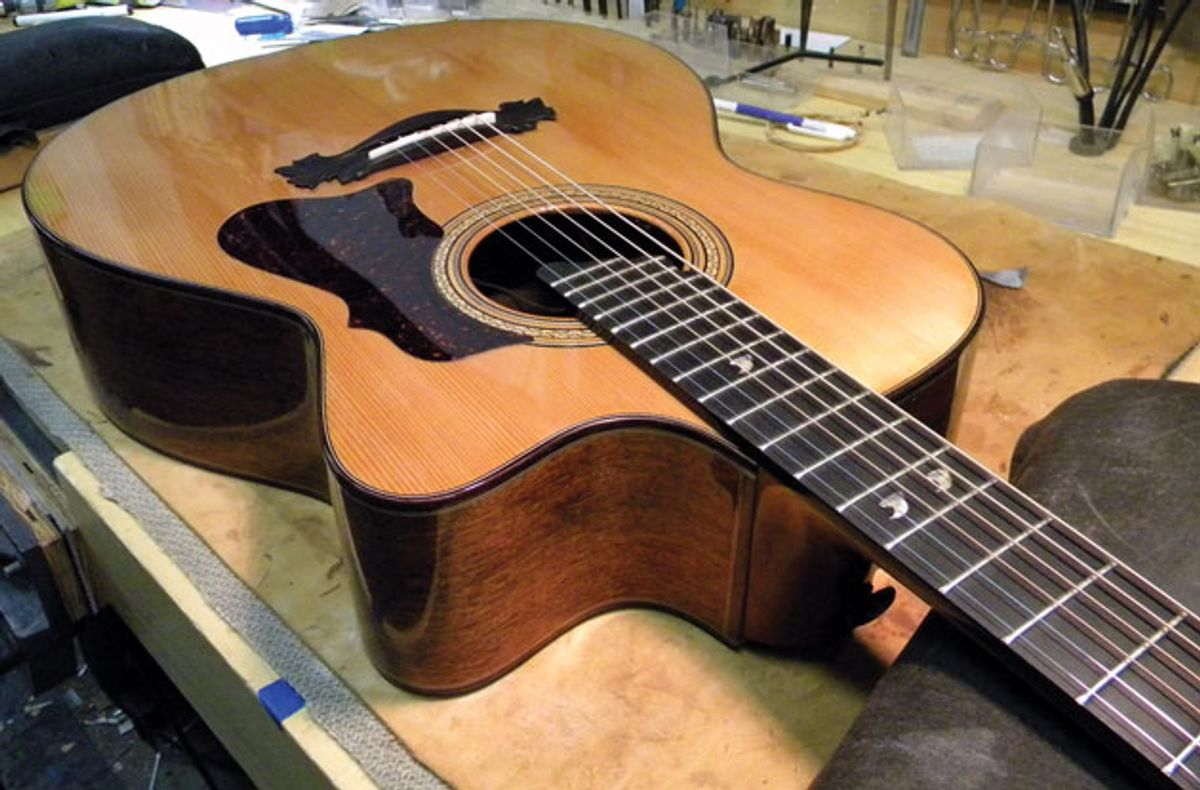
If it’s hard to coax rich tones from your acoustic, your guitar may need to have its frets leveled.
When you play your guitar, pushing its strings down against the frets causes them to wear. Depending on how hard you grip the strings, this metal-to-metal contact can cause the frets to develop divots or small depressions. As a guitar’s frets become uneven, vibrating strings lose sustain and clarity, intonation gets compromised, bending can become difficult, and it can feel like you’re fighting to get good tone from your guitar.
Eventually you may need to replace worn frets with new ones—a job for a professional—but before you reach that point, there’s a lot you can do yourself to keep your guitar in good playing condition.
People use different terms to describe basic fret maintenance. I’ve heard it called fret leveling, fret treatment, recrowning, grind and polish, and fret milling. Whatever you call it, the process and goal is always the same, and that is to reshape and recrown the frets so they have an equal height (with the exception of the last five to eight frets, which I’ll explain in a moment).
But first, a word of caution: Fret leveling is not a casual project. Unlike adjusting pickup height or intonation or a truss rod, it involves actions that can’t be undone. To level and recrown frets, you need the proper tools, a steady hand, and a lot of patience. The tools alone will probably cost more than hiring a pro to do the job on a single guitar. If you have several guitars and an innate interest in maintaining them, learning to level frets can be worthwhile. But if you’re not prepared to invest in the tools or take the time required to execute this delicate task, then do yourself a favor and take your guitar to a qualified tech.
That said, even if you decide to hire someone to level your frets, understanding what’s involved can be useful—especially if you buy used guitars or deal regularly with guitar techs. Knowledge is power, as they say, so read on.
Project overview. To illustrate the fret leveling process, we’ll use a Manea jumbo acoustic a client recently brought in for work (Photo 1). It’s a great-sounding instrument, but over time the frets have become uneven and many are no longer properly seated in the fretboard. Our task is to seat those frets securely into the fretboard, and then level and crown all of them.
Photo 2
Before you start a project, it’s important to gather the necessary tools and supplies. Photo 2 shows the items I use for a fret level: a 24" fret leveling bar, a two-sided fret crowning file (designed to round the top of both small and medium fretwire), a fretting hammer, a truss rod wrench, self-adhesive sandpaper (400 and 1500 grit), thin superglue, razor blades, 0000 steel wool or Planet Waves fret-polishing paper, and a flathead screwdriver.
You can purchase most of these tools and materials at a home improvement store or online from such retailers as Stewart-MacDonald.
You need to immobilize the guitar to perform accurate fretwork. To support the neck, I use a 25-pound bag of buckshot wrapped in leather. Alternatively, you can use a bag of sand that’s similarly wrapped. I also rest the guitar body on a piece of leather to protect the instrument and keep it from sliding around.
Photo 3
Finally, I strongly recommend placing a guard over the soundboard in case you slip with a tool while leveling or recrowning the frets. This protective surface—a thin sheet of plastic or even cardboard—should cover the top around the fretboard extension (Photo 3). Make sure the guard is thin enough that you can access the frets, yet thick enough to provide protection from sharp tools. You can secure it with blue painter’s tape.
Photo 4
Size matters. Before you begin grinding on the frets, you need to confirm they’re tall enough to level and recrown. To do this, I use a luthier’s digital caliper. Available from stewmac.com, the tool is designed to let you measure fret height right off the fretboard. On this Manea, the fret height measured .043"—a good height for frets on an acoustic guitar. If the current frets measure less than .038", they’ll be too difficult to recrown after being leveled, and that means new frets are required.
Tap and seal. After removing the strings, place the guitar neck onto a secure platform, and then remove the nut (I demonstrate removing a nut in this PG DIY video, “How to Convert a Flattop into a High-Strung Guitar”).
Next, check the frets to make sure they’re securely seated in the fretboard. Shine a bright light along the fretboard to see if any frets have sprung loose from their slots. The flat bottom of the crown should sit flush to the wood. If you see a fret that’s come up, gently tap it down with a fretting hammer and then run a bead of thin superglue along each side of the fret to hold it in place.
Drop Off and Fall Away
Most acoustic guitars have what’s called a fall away or drop off at the end of the fretboard where it extends over the top. This is a result of the neck angling down very slightly into the guitar to provide room for the strings to vibrate without hitting the frets. If the fretboard doesn’t drop off, it could be a sign of a low neck angle. If you see this on your guitar, I recommend you take it to a qualified luthier for advice. Correcting low neck angle requires major surgery. At the very least, the frets over the fretboard extension may have to be dramatically filed down.
Note: Whenever you have superglue in one hand, always have a Q-tip in the other. The Q-tip lets you quickly soak up any excess glue (Photo 4). Be very sparing when applying glue along the frets. If you use too much, it can spill over onto the neck. Thin superglue travels fast, so be ready with your Q-tip.
Leveling the frets. Once the frets are all seated, it’s time to begin leveling them. Different luthiers have different techniques for doing this. Here’s my approach: Place the leveling bar across the frets and adjust the truss rod until the bar is touching most—if not all—the frets. This process can take several attempts, so be patient.
Once the leveling bar is touching as evenly as possible, attach 400 grit self-adhesive sandpaper to the leveling bar, place it perpendicular to the frets, and then gently begin sliding the leveling bar along the frets. I like to start on the bass side and gradually work my way to the treble side of the fretboard. Don’t press too hard, just skim the surface of the frets with slow, controlled motions.
After a few passes, check the frets for scuff marks. Again, use a bright light to see if you are contacting all the frets evenly. If not, then you may have to readjust the truss rod. Keep using your leveling bar to remove more fret material.
Photo 5
About those last few frets. When the frets are perfectly even, they should all have file marks with the exception of the last five to eight frets (Photo 5). If those last several frets don’t have any file marks, but the rest of the frets do, that’s okay. It just means the fretboard has what’s called a fall away or drop off. For more details, read the “Drop Off and Fall Away” sidebar.
However, if you see you’re filing the last few frets, but not the frets in the middle of the fretboard, there’s a problem. Either the truss rod is too loose, which creates a bow or dip in the middle of the neck, or the fretboard has a “kick-up.” The latter is a condition that requires professional surgery to repair.
Recrowning. To ensure that a guitar intonates correctly and plays comfortably, the newly flattened frets need to be shaped to provide a narrow, precise point of contact for the string. This is called recrowning.
Photo 6
Fret-crowning files have concave grinding surfaces that run along their edge. Typically each edge is a different size to accommodate different widths of fretwire (Photo 6).
Once you choose the appropriate edge of the file to fit your fretwire, place the file along the top of a fret, and glide it forward, filing in only one direction. Use slow, gentle strokes to remove metal from each side of the fret, while leaving the top untouched. The goal is to produce a nicely rounded playing surface with a peak that runs along the center of the fret.
After every few passes, clean your file with a wire brush to prevent metal build-up in its teeth. Repeat this process for every fret. Some frets will take longer than others to crown, so take your time and be thorough. When the job is finished, you should see a thin line of scuffmarks running along each fret that’s about the width of a high-E string.
When the frets are all recrowned, change the sandpaper on the leveling bar to 1500 grit. Using a light touch, glide the bar along the frets parallel with the neck to confirm that the fret tops are all level. If they are, then glide the leveling bar over the frets once more, this time working along the length of the frets, perpendicular to the neck. This will remove the scuffmarks and smooth out any inconsistencies on the crown of the frets.
Finishing touches. Now we enter the clean-up phase. To remove any tool marks left in the wood by your recrowning file, carefully scrape the fretboard with a razor blade. Exercise caution and don’t push too hard. If you slip, you might gouge the fretboard or even the frets you just worked so hard to reshape. With any tool marks removed, you’re ready to polish the frets with 0000-steel wool to make them look perfect.
Tip: Whenever you use steel wool around magnetic pickups, first cover them with painter’s tape to prevent little metal fibers from collecting on the pole pieces.
Finally, reinstall the string nut, put on a new set of strings, and enjoy the feel of freshly leveled, crowned, and polished frets.
